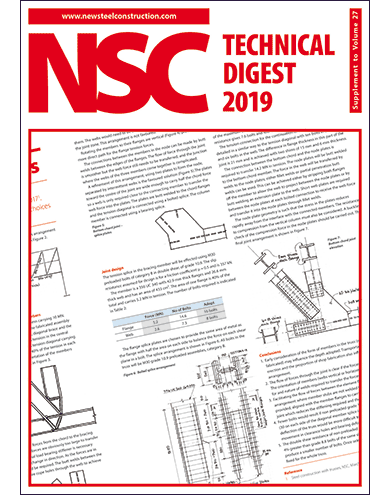Technical
AD 314: Columns Splices and Internal Moments
Today, with a higher emphasis of site safety than ever, the provision of temporary barriers around the perimeter of buildings and edge of floor openings is common practice. For columns in these locations their splices are often located well above the level of the floor steelwork because the extended column provides a convenient means of connecting the barrier. It may be convenient to carry the lateral loading on the barrier horizontally back to the columns rather than to the edge beam below. This is because loading carried to the beam may induce torques which would need to be included in the design of the beam during the temporary condition. Traditionally, splices levels in columns were located between 500 mm and 750 mm above the top of steel level for the floor beams but are now often situated at 1.2 The to 1.5 metres above the top of the floor steelwork and on occasions at mid height in the column. The Advisory Desk has received many questions concerning the design requirements regarding internal moments and stiffness for these column splices. This AD note only provides background advice explaining the need to allow for such moments because the central technical requirements have already been covered in Advisory Desk Notes AD 243 and AD 244. These relate to Annexes B3, C3 and I5 in BS 5950-1: 2000.
Where possible splices should be situated as close as practicable to restrained points (points of inflection) in the member, which is the practice recommended in clauses 6.1.8.2 and 6.1.8.4. They will not then have to be designed for the additional moments that are described in the above annexes; however, they have of course to be designed for their applied moments and axial load. The column splices described in SCI-P-212 Joints in Steel Construction Simple Connections are examples of this type of splice and are usually situated about 500 mm above the level of the floor steelwork.
If the splice has to be located away from a restrained point in the member for whatever reason it will have to be designed for its applied moments and axial load as before, as well as an appropriate combination of internal moments that are described in the above annexes.
When members are designed for flexural or lateral-torsional buckling (LTB), BS 5950-1: 2000 provides procedures for calculating reduced strengths pc and pb. These reduced strengths are used to determine the resistance of the member in relatively simple design procedures. However, at the critical cross section at collapse the maximum stress in the member is equal to the material design strength of the member, py, not the reduced design strength. This is easiest shown for a member subject to axial load (flexural buckling) alone although a similar case could be presented for lateral-torsional buckling.
Figure 1 shows a pin ended axially loaded strut on the verge of collapse and its associated strut buckling curve from BS 5950-1. For its effective length, λ, the compressive strength pc can be determined (Table 24) which will allow the maximum axial load, F, which the strut can carry to be calculated. The important thing to note however is that with the strut model used in BS 5950-1 the column is deemed to fail when the stress on the compression face of the column at the critical cross section reaches its design material strength py. The difference between the material strength py and compressive strength pc, marked x on the strut buckling curve for the effective length, λ, is that which arises from the additional moment in the strut from bowing. This effect is called strut action and produces an additional internal or secondary moment. This effect occurs about both axis. A splice must carry this internal moment as well as the axial load F.
Likewise a similar case can be presented which shows that an additional internal (secondary) minor axis moment also arises in the case of lateral-torsional buckling.
Strut action is covered in Annex C.3 and Annex B.3 deals with the additional internal moment that arises due to LTB. Both annexes also provide equations for calculating the value of the moments along the length of the member between points of inflection which is useful when the splice is situated nether close to a point of restraint nor at the critical cross section in the member. Annex I.5 deals with the case when both buckling phenomena occur simultaneously which includes more additional internal moments because the two phenomena augment each other. Splices away from points of restraint have to be designed for these internal or secondary moments as well as their applied moments and axial load.
Splices should also be designed for the tying forces that occur when structural integrity requirements apply. Non-preloaded bolts are often used in column splices unless tension develops in the splice and the resulting slip is unacceptable. If this situation arises preloaded bolts may be used in the splice to avoid slip. The chapter on column splices in SCI-P-212 Joints in Steel Construction Simple Connections offers guidance in this regard.
The internal moments described in this Advisory Desk note also apply to welded splices when located away from points of restraint although their consideration is academic when full penetration butt welds are used.
BS 5950-1: 2000 says very little about stiffness at splice locations although Clauses 6.1.8.2 and 6.1.8.4 mention it in parts. Another Advisory Desk note will follow which will provide advice on this issue.
Contact: Thomas Cosgrove
Tel: 01344 636525
Email: t.cosgrove@steel-sci.com
In order to retain the accurate formatting of the equations in this advisory desk, this article is available as a pdf download only.
Click here to download and view it.












